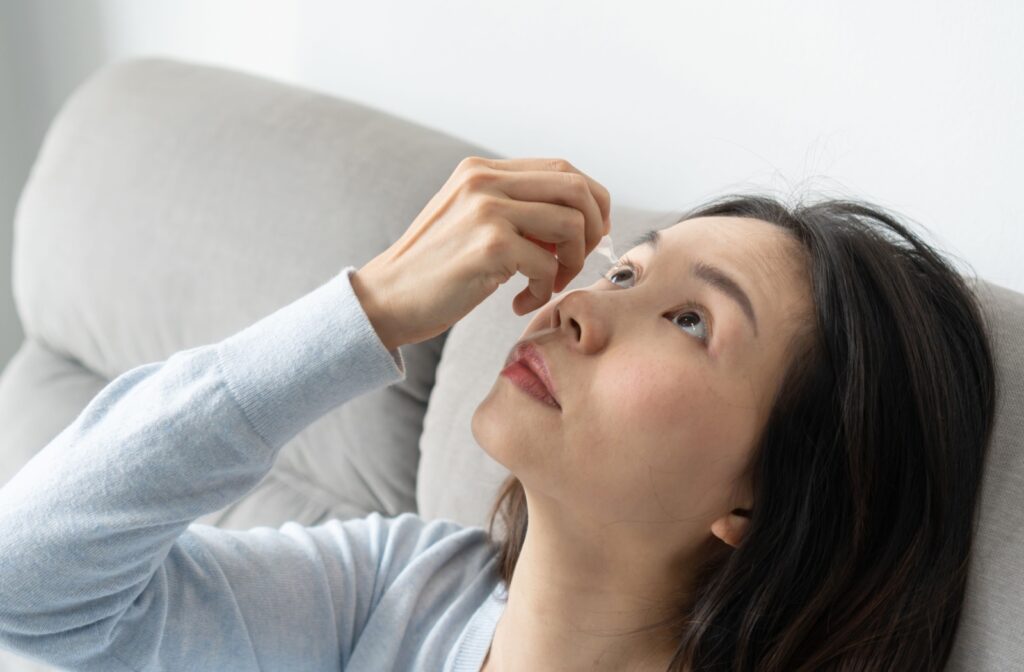Dry eye is more than just irritation or redness—it can also have a noticeable impact on how clearly you see. Many people with dry eye experience fluctuating vision that worsens throughout the day, especially during screen use or in dry environments.
Blurry vision is a common symptom of dry eye. It’s caused when your tear film becomes unstable, preventing light from properly focusing on your eye.
By learning how dry eye affects your vision and what treatments can help, you can take simple steps to improve comfort and clarity in daily life.
The Connection Between Blurry Vision & Dry Eye
Your tear film is your eye’s first layer of protection. It keeps your vision clear and comfortable.
The tear film has three parts: a protective oil layer, a watery layer, and a sticky mucus layer. When any part of this system breaks down, your tears can’t coat the eye properly, leading to blurry or fluctuating vision.
An unstable tear film makes the eye’s surface uneven, causing light to scatter and blur your vision. Many people notice clearer vision after blinking, but it quickly becomes blurry again as the tears dry out. Inflammation can make things worse by damaging the eye’s surface and blocking the oil glands (meibomian glands) that keep tears from evaporating too fast.
Common Causes of Dry Eye Syndrome
Many factors can contribute to dry eye symptoms, affecting people of all ages. Understanding these common causes can help you identify triggers and seek the right care.
- Age: Tear production naturally decreases with age, especially after 50.
- Environment: Wind, smoke, air conditioning, and low humidity can cause faster tear evaporation, with symptoms often worsening in winter.
- Medical conditions: Autoimmune conditions like rheumatoid arthritis, Sjögren’s syndrome, lupus, as well as diabetes and thyroid issues, are all linked to dry eye.
- Hormonal changes: Hormonal shifts, particularly after menopause, can reduce tear quality and quantity.
- Medications: Common drugs like antihistamines, decongestants, antidepressants, and beta-blockers can lower tear production.
- Screen time: Long hours on computers or digital devices lower your blink rate, leading to dry eye symptoms known as digital eye strain.
Recognizing these causes is a helpful first step toward improving your eye comfort and getting appropriate treatment.
Recognizing Dry Eye Symptoms
Dry eye syndrome can cause a range of symptoms that often come and go. Recognizing these signs can help you identify when it’s time to seek treatment.
- Blurry vision: Vision may become blurry, especially between blinks, and often clears temporarily after blinking.
- Redness: Eyes can look bloodshot or irritated, especially around the lower eyelids.
- Burning or stinging: Many people feel a burning, stinging, or gritty sensation, like having sand in their eyes.
- Excessive tearing: Ironically, dry eyes can cause too many tears, though these reflex tears do not properly moisturize the eyes.
- Light sensitivity: Bright lights, screens, or fluorescent lighting may feel uncomfortable or cause more irritation.
Paying attention to these common symptoms can help you catch dry eye early and find the right relief.
Treatments for Dry Eye Syndrome
Dry eye treatment depends on the severity of your symptoms and what is causing them. Many people benefit from a combination of therapies to manage dryness and improve comfort.
- Artificial tears: Artificial tears are often the first step in treating mild dry eye. These over-the-counter eye drops add moisture to the eyes and provide quick, temporary relief from dryness and irritation.
- Prescription eye drops: For more persistent symptoms, prescription medications may be used to reduce inflammation or stimulate natural tear production. These treatments help improve tear film quality over time.
- Punctal plugs: Punctal plugs are tiny devices placed in the tear ducts to slow tear drainage, thereby reducing dryness and irritation. Both temporary and long-term options are available.
- Lipid-based eye drops: These specialized eye drops target meibomian gland dysfunction, improving the oily layer of tears and preventing evaporation. They are helpful for people with evaporative dry eye.
- Intense pulsed light (IPL) therapy: IPL therapy uses gentle light pulses around the eyes to improve meibomian gland function and reduce inflammation, offering longer-term symptom relief.
- Thermal pulsation treatments: Thermal treatments gently warm and massage the eyelids to unclog blocked glands, improving natural oil flow and stabilizing the tear film.

Lifestyle Changes to Help With Dry Eye
Along with medical treatments, simple daily habits can make a big difference in managing dry eye symptoms.
- Stay hydrated: Drinking enough water supports healthy tear production throughout the day.
- Practice blinking exercises: Regular, conscious blinking—especially during screen use—helps maintain a stable tear film.
- Use a humidifier: Adding moisture to indoor air reduces tear evaporation, especially in winter or dry environments.
- Adjust screen position: Keep screens below eye level to minimize eye surface exposure and slow tear evaporation.
- Take regular screen breaks: Follow the 20-20-20 rule—every 20 minutes, look at something 20 feet away for 20 seconds.
- Add omega-3s to your diet: Eat foods like fish, flaxseeds, and walnuts or take omega-3 supplements to help reduce inflammation.
- Maintain eyelid hygiene: Use warm compresses and gentle eyelid massage to improve meibomian gland health.
- Wear protective eyewear: Wraparound sunglasses or moisture chamber glasses can shield eyes from wind, dust, and dry air.
These small changes can help ease symptoms and support your overall eye comfort.
Moving Forward With Clear Vision
Dry eye syndrome can lead to constant irritation and blurry vision, but with the right care, these symptoms can be managed. At InVision Eye Care, we use diagnostic tools and personalized treatment plans to identify the cause of your dry eye and provide effective relief. From comprehensive eye exams to targeted therapies, our team is here to help you achieve clearer, more comfortable vision.
Book your eye exam with InVision Eye Care today and take an important step toward improving your eye health.



